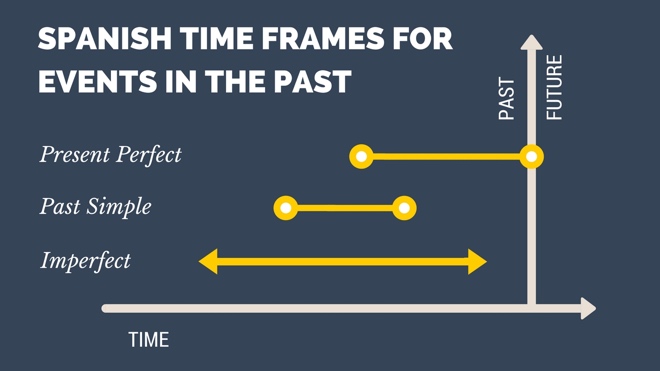If you want to learn the Spanish present perfect tense, you only have to know one verb conjugation, how to form a past participle and a few phrases that trigger this tense.
As a tense, the Spanish present perfect gives so much in terms of versatility and simplicity.
The Spanish present perfect is also the first tense I recommend Spanish students learn in order to start talking about the past in Spanish. It’s one of the best Spanish grammar hacks that will allow you to speak Spanish faster.
Moreover, I recommend you start with this tense because it is the easiest Spanish past tense to learn and you can use it in a lot of situations (even when it is technically wrong).
That said, when you combine the present perfect with the phrases in this post you will avoid any grammatical errors.
In this article, you’ll learn how and when to use the Spanish present perfect tense. You’ll also learn 8 Spanish phrases that trigger the use of this tense.
How to form the Spanish present perfect tense
To form the Spanish present perfect, known in Spanish as el pretérito perfecto, you’ll need to combine the present conjugations of haber with a past participle.
The formula looks as follows:
Pretérito perfecto = Haber + participio.
Firstly, here is a list of the present conjugations of haber:
| Person | Haber |
|---|---|
| Yo | He |
| Tú | Has |
| Él / Ella | Ha |
| Nosotros | Hemos |
| Vosotros | Habéis |
| Ellos | Han |
Next, you need to form a past participle for the verb you want to use in this tense.
To form past participles for regular ar verbs, you need to remove the ar and replace it with an ado. For example:
Hablar → Hablado.
To form past participles for regular er and ir verbs, you need to remove the er or ir and replace it with an ido. As follows:
Conocer → Conocido.
Now you can combine haber and past participles to form the present perfect. Here are a few quick examples (more examples later on):
English: I have eaten.
Español: He comido.
English: They have said it.
Español: Lo han dicho.
English: We have gone to the market.
Español: Hemos ido al mercado.
Another post I wrote this week explains how to form the past participles in more detail and includes a list of all of the irregular past participles. To master this tense, you’ll need to learn the irregular past participles and then get used to applying the phrases below.
Next, when exactly is the right time to use the Spanish present perfect tense?
When to use the present perfect tense
The next thing you need to consider is the time frame for which the present perfect applies.
Here you can see there are three main Spanish time frames for events in the past:

What this graph is demonstrating is that a past event could occur in one of the following time frames:
- Started recently and stopped recently (especially with reference to the present time frame).
- Started and stopped at two well-defined points in the past.
- Continued for a long period of time, and had no clearly defined start and stop point.
These three descriptions broadly describe the use of the present perfect tense (this article), the past simple tense and the past imperfect tense.
To reiterate, any event that started and stopped in a time frame that is related to the present moment requires the use of the present perfect tense.
For example, if you went to the bank this morning, then this action has happened on this day (today). And, since today isn’t over yet, you need to use the present perfect tense.
There are a lot of nuances and questions that can arise around this topic. For instance, you may think that you are now in the afternoon and the morning is over so this would call for the past simple. But, this isn’t the case. The key is to notice the word ‘this’.
In contrast, if something happened yesterday morning, then the word ‘yesterday’ would call for the past simple.
But, again, if something happened ‘this week’, ‘this month’ or ‘this year’ then these phrases all call for the present perfect.
That said, here, I’m jumping the gun, in the next section we’ll spend a lot more time on the phrases that trigger the Spanish present perfect tense.
Spanish phrases that trigger the present perfect tense
Since the present perfect requires an event to start (often recently) and continue into the present moment, then all phrases that trigger the present perfect will imply this timeline for the events of the sentence.
1. Today – Hoy
Whenever you want to talk about something that has happened today, you should use the present perfect.
English: Today, I went to the gym.
Español: Hoy, he ido al gimnasio.
English: We finished our last exam today.
Español: Hemos terminado nuestro último examen hoy.
2. This morning, this afternoon, this evening – Esta mañana, esta tarde, esta noche
As I mentioned earlier, even if something happened this morning and you are currently in the middle of the afternoon you still need to use the present perfect.
English: This morning I got up at six.
Español: Esta mañana me he levantado a las seis.
English: This afternoon we ate in the park.
Español: Esta tarde hemos comido en el parque.
Also, please note that this use can vary regionally, check out this article on Spanish dialects and regional differences for more details.
3. This week, this month, this year – Esta semana, este mes, este año
Continuing with the use of the word ‘this’, you can also talk about wider timeframes such as ‘this month’ or ‘this year’.
English: This month I have been very busy.
Español: Este mes he estado muy ocupado.
English: My parents returned from vacation this week.
Español: Mis padres han vuelto de sus vacaciones esta semana.
4. Lately, recently – Últimamente, recientemente
A more subtle and less descriptive version of ‘this day, week, month etc.’ is lately or recently.
English: I recently met an amazing girl.
Español: Recientemente, he conocido a una chica increíble.
English: I recently realised what I have to do to solve this problem.
Español: Hace poco me he dado cuenta de lo que tengo que hacer para resolver este problema.
5. Never, ever – Nunca, jamás
The next three phrases extend to timeframes that expand across your whole life and, again, continue into the present moment.
If you have ‘never’ tried something, this is as true in the present moment as it was when you were born.
English: I have never tried octopus.
Español: Nunca he probado el pulpo.
English: He has never written anything like that.
Español: Él jamás ha escrito nada así.
6. Already, still – Ya, todavía
If you ‘still’ haven’t done something or it has ‘already’ been done, then often action occurred the present time period and therefore we need the present perfect tense.
English: You still haven’t gone to the doctor?
Español: ¿Todavía no has ido al médico?
English: I have already finished my homework.
Español: Ya he terminado mis deberes.
Learn more about ya and todavía in this article.
7. All my life, in my life – Toda mi vida, en la vida.
Similar to the ‘never’ and ‘already’ triggers, ‘all my life’ triggers the present perfect.
English: I haven’t heard anything so strange in my life.
Español: No he oído nada tan extraño en mi vida.
English: All my life I haven’t left the country.
Español: Toda mi vida no he salido del país.
8. Some time, a few times, several times, # times – Alguna vez, algunas veces, varias veces, # veces
If you are counting the number of times you have done something, you should use the present perfect.
English: I have been to this restaurant ten times.
Español: He estado en este restaurante diez veces.
English: I have tried to stop smoking several times.
Español: He intentado dejar de fumar varias veces.
Your Turn
I mentioned earlier that the choice of when to use present perfect isn’t straightforward. The phrases from this post do, however, make your life easier.
Choose some phrases from this post and then try them out when you next get an opportunity.
It is worth testing your use of this tense against the use of the past preterite because they are a common challenge for Spanish students.
What other sentences in the present perfect can you create using these sentences?




He apreciado muchas veces tus lecciones.
I love the visual aid of the graph. It’s great! I’m interested in learning more about when to use past preterite and past imperfect… I live in VZ and It seems like they are used almost interchangeably but I know there is a difference. I asked some locals to explain the difference and they said there is no difference, but often native speakers don’t realize the difference because they they learned naturally. I have see if you’ve done an explanation of that already.
Hola Kristin, yes, we have a few articles on the past preterite here and the past imperfect where you can read more about these two tenses. You can search for the articles using the search feature at the top of the website.
Muchas gracias 🙂
I think I’ve gotten a good sense for when to use the present perfect vs. the simple past, thank you! But I do have a couple of questions. A spanish teacher on a podcast I recently listened to said that ayer, anoche and hace [x amount of time] would be signals for using the present perfect, but you say they’re signals for the simple past. Is that a gray area at all, or is it always simple past?
I also was conversing with a native spanish speaker on Monday, who asked me about my weekend. Since I was using “este fin de semana”, I used present perfect, but she corrected me and said that was simple past. Intuitively it makes sense, but can you explain why, since it’s this weekend? Is it because the weekend at that point was over?
Hola Steph, these are great questions!
Firstly, “ayer” and “anoche” are not triggers for the present perfect, I don’t think there is a grey area here and this rule is pretty consistent throughout the Spanish speaking world. In contrast, “hace poco”, “hace un momento”, “hace un rato” (e.g. a moment ago) is a trigger for the present perfect, but “hace dos días”, “hace dos semanas” etc. is a trigger for the past simple. So “hace + tiempo” depends on how much time has passed.
Your next question… in general I think it is better in Spanish to avoid using “este” unless you are in that time period. E.g. if it is Sunday, we can say “este fin de semana”. But if it is Monday to Friday, it is better to say “el fin de semana” and then use the past tense to refer to the previous weekend, and the “ir + a” phrase to refer to the coming weekend. For example:
What did you do on the weekend? – ¿Qué hiciste el fin de semana?”
What are you going to do on the weekend? – ¿Qué vas a hacer el fin de semana?”
In English, we could replace “on the” with “this” in both of these sentences but then they become harder to translate to Spanish. Also note that “on the” simply becomes “el”.
Thanks, Andrew, that is helpful. I do think I have the feel for when to use which tense pretty well now. And I appreciate the feedback on “este”. Totally makes sense. You are a great teacher! 🙂
hi I just wanted to say, to a young person, this is very easy to understand and makes my life in my Spanish lessons a lot easier. So thanks 🙂
Thanks Syeda, I’m glad it helped 🙂
Thanks a bunch for this!
I have a question about two of the phrases that trigger the present perfect: “Today” and “This morning/this afternoon/this evening”. Shouldn’t these trigger the preterite? According to Spanish Dict:
“The preterite is used to talk about completed actions in the past. More specifically, it is used to talk about beginnings and ends, things that took place on specific days or dates, at specific times or during specific time periods, and events in a sequence.
If I did something earlier today that had a specific beginning and end, i.e., going to the bank, shouldn’t that be the preterite? Also, every translation engine I tried used the preterite for that.
Thanks 🙂
Hola Caleb, thanks for the question. This one is very country dependent!! In Spain, you have to use the present perfect in this context. In Mexico, you’ll likely use the past simple (preterite) depending on the context. And in other countries such as Peru or Colombia, the uses are in between Spain and Mexico.
In Mexico, definitely use the preterite when talking about a completed action which you did this morning, yesterday, last night, etc.
And preterite is the 1st past tense taught here.
Thanks John. Yes, when talking about an action completed yesterday or last night, then we need to use the past simple (preterite) and this is the same in every Spanish-speaking country. When talking about “this morning”, then this changes from country to country. But, the reason I suggest students start with the present perfect is because it’s the easiest past tense to form and hence easier for beginners to get their point across in a conversational setting without having to learn all of the irregular conjugations that come with the past simple tense.
This is what I find confusing. The tense you are teaching in this lesson you call “present perfect”. my conjugation app (El Conjugador) calls it “Preterito perfecto compuesto”. They call your “simple past” “preterito perfecto simple”. Why can’t it be called the same thing everywhere?
Yes, Terry, you’re right! Spanish, just like English, has a few different names for these tenses. In English, we can call the tense “I ate”, “I went” as the ‘preterite’, ‘simple past’, ‘past simple’ or ‘past indefinite’. And, in Spanish, there are a number of different names as well. My personal preference is “past simple” in English and “pretérito indefinido” in Spanish, and “present perfect’ in English and “pretérito perfecto” in Spanish. To answer you question about “why can’t it be called the same thing everywhere? You’ll probably have to go back in time and carefully manage how Latin languages, Celtic languages and Germanic languages all feed into one another.
La lección es muy útil. Gracias!
Gracias Chris 🙂
Extremely helpful. Cleared up a lot of doubts . . . thanks!
You’re welcome Garry!! 🙂
Hi, my question is if listing things you have done all day do you have to keep using the conjugated haber. eg. I´ve been to the bank, spoken to the lady, walked home and made dinner.
He ido el banco, hablado con la mujer, regresado la casa y hecho le cena. or do I need to put he hablado….he regresado……he hecho etc.
Hola Sarah, this is not common in Spanish so I wouldn’t recommend it. But, it’s possible that some natives might use a combination like this in certain informal situations.
Todavía no he ido a Columbia. Me he quedado todo el año en mi país y muchas veces he pensado que ahora es tiempo para planear un viajo en 2023.
¡Muy bien Theresa! 🙂 Me suena una buena idea.
Por ejemplo: I started to learn Spanish 6 month ago
A) He empezado aprender español hace 6 meses
B) Empecé aprender español hace 6 meses?
Gracias!
Hola Casey, your second example (B) would be the better option in this case. And we also need the preposition “a”, so we could say “Empecé a aprender español hace 6 meses”.
Thank you, Andrew. Your help has been invaluable as I’ve been learning Spanish for the past three months. It has boosted my confidence in writing my own sentences. Do you offer any free online discussion meetings for beginners like me to practice Spanish conversation in real-life situations? If so, I would really appreciate it.
Hola Shahrzad, I’m glad you are enjoying the articles! 🙂 We don’t offer free online classes, but we do provide paid Spanish classes if you are interested.